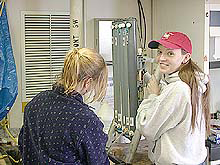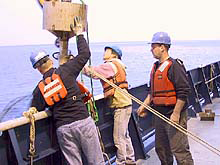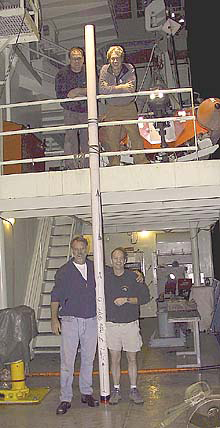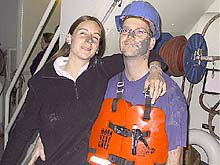
Sarah Flood Page working with Naomi Ward to collect water samples from Niskin bottles that were just taken off the Alvin submersible after a dive on Murray Seamount. Click image for larger view.
First Research Cruise: The Experience of an Undergraduate Student
July 10, 2002
Sarah R. Flood Page
Senior Marine Biology Major
University of California, Santa Cruz
This is my first research cruise and I feel really fortunate, as an undergrad, to be here and to be participating in research and work that up until now I had only read about. I feel especially lucky that on my very first cruise, I was able to dive in the Alvin!
My Alvin dive was on Murray Seamount, and our initial depth was 3,038 meters! I was able to see an environment that few people ever get to see. It was amazing to be down so deep in the ocean. It truly felt like an alien environment. There was no light, because light only penetrates through water for about 150 meters. After that, it is pitch black. On the way down, there were swarms of tiny, neon green, glowing, bioluminescent jellyfish, which were really cool to watch. When we neared the bottom, the pilot turned on the lights and we watched the bottom come into view – seemingly out of nowhere. There were few animals at 3,000 meters, but the animals that were there were amazing because the crabs, fish, and sponges that live at depth are all adapted to life in the cold and darkness of the deep sea. We brought up some bizarre-looking gooseneck barnacles, which were living on a stalk of dead coral, and there was an encrusting coral on top of the barnacles. The odds are low that it is a newly discovered species, but it was exciting because no one knew the exact species when we brought it on board. Our dive was almost eight hours, with over five hours of actual bottom time. I expected to feel very isolated at the bottom, but the sphere inside the Alvin was so small that I felt very protected. It was amazing to see with my own eyes what I've been watching on video for two weeks. It was an unforgettable experience that I wouldn't give up for anything!
I want to be a marine biologist because I love animals, the ocean, and learning. My problem is scope - there is so much out there to be studied, and I cannot study it all. So how did I end up on this cruise, working on a very specific project? At UCSC I am developing a senior thesis project on growth patterns of a small, solitary, intertidal cup coral. My thesis advisor, Don Potts, was in contact with Tom Guilderson, the professor I'm working for now. Tom needed an undergraduate assistant and my name came up. So here I am, on the R/V Atlantis, in the middle of the Gulf of Alaska.
Aside from the dive, the best part about this cruise is that there is so much to learn. I am here with a group studying climate change as recorded in the chemical composition of deep-sea corals and sediment. There are also crab biologists and marine geologists on board, and because they are all so passionate about what they do, I'm learning from everyone. Even though we're focusing on the bottom of the ocean, there is still a lot of activity on the surface. So far on this cruise, I've seen fin whales, the second largest whales after blue whales, and northern fur seals and puffins, right off of the bow of the ship! To be this close to open ocean life is amazing.
Being on this ship has been just great. I'm learning what at-sea research is really about; it is not just the science. It's a unique living and working situation on a ship. Some days are packed with activity and I'm up until 5:00 a.m., and other days there is virtually nothing to be done. I'm never more than 100 yards from my lab, even when I'm sleeping. The learning curve out here is steep, so I'm learning a lot very quickly. My personal life is centered around meals and e-mail transfers! These are probably the most intense 23 days of my academic career, and I am so very grateful to have this experience.

Rob Hill, Patrick Hennessy, and Brendan Roark (left to right) putting the gravity corer over the side. Image courtesy of Rob Dunbar. Click image for larger view.
Exploring the Interdependence of Geology and Biology on Seamounts
Thomas P. Guilderson, Ph.D.
Center for AMS, LLNL and Dept. of Ocean Sciences
Univ. of California, Santa Cruz
One of the main objectives of this cruise was to recover long sediment sequences from the seamounts. We use sediment cores as a means to travel back through time. As the sediment slowly accumulates, it preserves a record of past oceanic conditions in microfossils (foraminifera) and the sediment geocheochemistry (what elements are there and how much). In general, sediment accumulates very slowly (2 to 3 cm per thousand years) unless you happen to be in a small basin such as a pond, or on a saddle (a low point between two high points) where it can accumulate at the rate of meters per thousand years!

Rob Dunbar, Tom Guilderson (“downstairs” left to right), Brendan Roark and Chris Moy (“upstairs” left to right) show the scale of the long gravity core. The mud fills the core to within approximately 15 centimeters from the top of the pipe. Image courtesy of Martin Fisk. Click image for larger view.
We soon realized that locating good coring areas on seamounts was no simple task because the strong currents that are associated with these undersea mountains prevent accumulation of sediments. We were very fortunate to find regions of deep sediment at Warwick Seamount, where we recovered a suite of giant gravity cores from the flanks ranging from 1 to 5 meters in length.
To locate good coring sites, we used detailed bathymetric maps and a profile of what the sub-bottom looked like. To obtain this profile, we used a sonar system that emits sound waves that penetrate the sediments on the sea floor and reflect back when they hit different layers. The 5-meter long cores will contain a record of the last 150,000 to 200,000 years.

Aftermath of a mud fight between Taylor Heyl and Tom Guilderson (from left to right) Image courtesy of Rob Dunbar. Click image for larger view.
After recovering the long cores, we let the mud settle by standing the core for 30 minutes – just enough time for a mud fight! We then cut the core into manageable sections for later analysis.
We will take the sediment cores back to our lab for processing. After running the cores through a magnetic susceptibility core logger (it measures the magnetic intensity of the sediment) we will split the cores lengthwise and take small samples approximately every 10 centimeters. A sub-split of the sample will be analyzed for sediment geochemistry to determine how much carbon, nitrogen and calcium carbonate are in it. The remainder of the sediment will be washed through fine sieves to collect the microfossils that will then be analyzed for their isotope chemistry (eg., oxygen isotopes which tell us about temperature and salinity).
Sign up for the Ocean Explorer E-mail Update List.


























